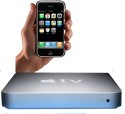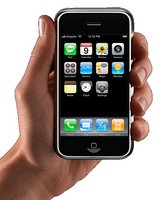Apple embeds Mac OS X in phone, set-top box
Jan 9, 2007 — by LinuxDevices Staff — from the LinuxDevices Archive — 2 views CEO Steve Jobs unveiled two forthcoming Apple devices based on an embedded version of Mac OS X, at the MacWorld Expo today in San Francisco. The “Apple TV” set-top box is due in February, while the much-anticipated iPhone combo cellphone/mediaplayer is expected by mid-year.
CEO Steve Jobs unveiled two forthcoming Apple devices based on an embedded version of Mac OS X, at the MacWorld Expo today in San Francisco. The “Apple TV” set-top box is due in February, while the much-anticipated iPhone combo cellphone/mediaplayer is expected by mid-year.
The Apple TV appears to be a fairly standard-issue DVR (digital video recorder), similar to the Linux-based TiVo and its many successors and imitators. The iPhone appears to be an ultra high-end smartphone, with WiFi, Bluetooth, possibly a GPS receiver, high-res touchscreen, integrated music player, and camera.


Apple TV and iPhone run embedded Mac OS X
(Click either to enlarge)
The two products appear to represent the first use — or at least the first high-profile use — of Mac OS X as an embedded operating system. The iPhone will likely be based on an ARM applications processor, since ARM is the architecture used by most if not all currently available smartphones.
Mac OS X is based on a fifth version of the Berkeley Software Distribution (BSD) Unix called “Darwin.” The other BSDs are:
- NetBSD — optimized for portability
- OpenBSD — optimized for security
- FreeBSD — optimized to have the most packages
- BSDI — a commercial version of BSD
Mac OS X was ported from PowerPC to Intel/x86 in 2005, when Apple switched processor suppliers. That porting effort probably made Mac OS X easier to port to ARM or whatever architecture will be used in the iPhone, as successive ports are often easier. For example, after Linux creator Linus Torvalds completed the initial port of Linux from x86 to Alpha around 1995 or so, ports to other architectures began appearing rapidly.
Thus, as computing and consumer electronics continue to converge, Apple could be well-positioned to deploy Mac OS X in devices based on a wide range of processor architectures. One of Unix's original design goals was hardware portability — as reflected in its original “Multix” name.
That said, Unix-based operating systems have not proven as popular or as successful as Linux for embedded applications, because BSD's licensing places no obligation on users to contribute their improvements back to the community. Thus, if Apple plans to use Mac OS X in a range of embedded devices, it will have to do all of its own development work. That might suit Apple's control-oriented approach to product development, but could result in serious feature shortfalls and cost overhead compared to products built on Linux by companies willing to collaborate more on the lowest-level portions of their products, such as kernels, device drivers, networking stacks, graphics frameworks, and so on.
Embedded giant Wind River actually purchased considerable BSD-related assents in 2001, but then quickly recognized its mistake and sold off the assets six months later. A year and a half later, it embarked on a strategic shift to Linux.
Lots more details about the iPhone and Apple TV can be found in these informative PC Magazine stories:
- iPhone Analysis: Apple's Revolution for the Few
- Jobs: 'Apple is Reinventing the Phone'
- Apple Officially Launches iPhone, Apple TV
Availability
Apple is already accepting orders for the $300 Apple TV set-top box, which it expects to deliver in February. The company is targeting June for delivery of the iPhone.
This article was originally published on LinuxDevices.com and has been donated to the open source community by QuinStreet Inc. Please visit LinuxToday.com for up-to-date news and articles about Linux and open source.